You are about to be introduced to a fundamentally new concept in record playing equipment--the new family of BIC turntables.
You will discover in them all the superiorities of manual turntables.
They are also the first belt-drive units that can be programmed to play a series of discs. A new generation of turntables has arrived.

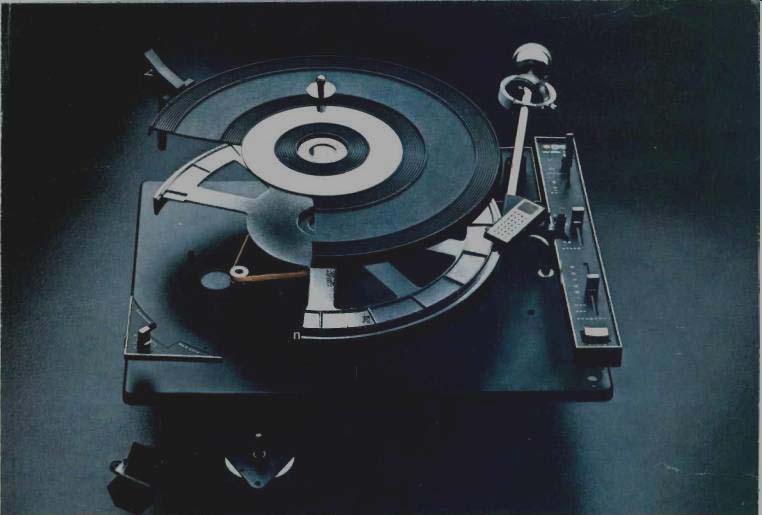
So, we have taken an unusual step.
We have created a warranty policy meant to be as solid as our turntables.
Your BIC 980 or 960 is fully warranted against defects in parts, materials, or workmanship for 2 full years. In addition, if it is found defective within 10 days after you buy it, your dealer is authorized to exchange it for a new one on the spot.
This warranty is the best testament to our faith in the fundamental excellence of these machines.
They are beautifully engineered and built.
They represent a departure from other designs, but a departure based on simplicity and rock-solid engineering and manufacture.
They eliminate the major objections which have been voiced by purists against automatic equipment.
They will be sold by leading audio specialists from coast to coast.
Your BIC authorized dealer will have a full-color, 26-page booklet which discusses these remarkable instruments in greater depth than we can here. If he has run out of these booklets, we will gladly mail one to you if you'll write to us at the address below.
The 980 and 960 are being delivered to your dealer now. We invite you to inspect them soon.
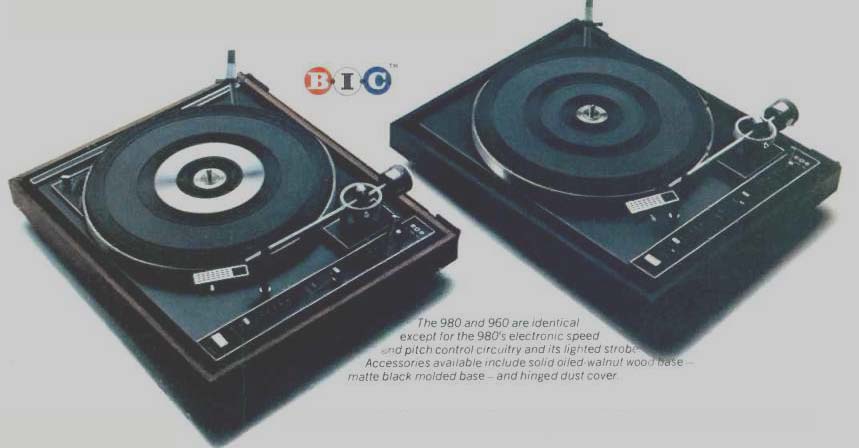
---The 980 and 960 are identical except for the 980's electronic speed and
pitch control circuitry and its lighted strobe. Accessories available include
solid oiled-walnut woo matte black molded base-and hinged dust cover.
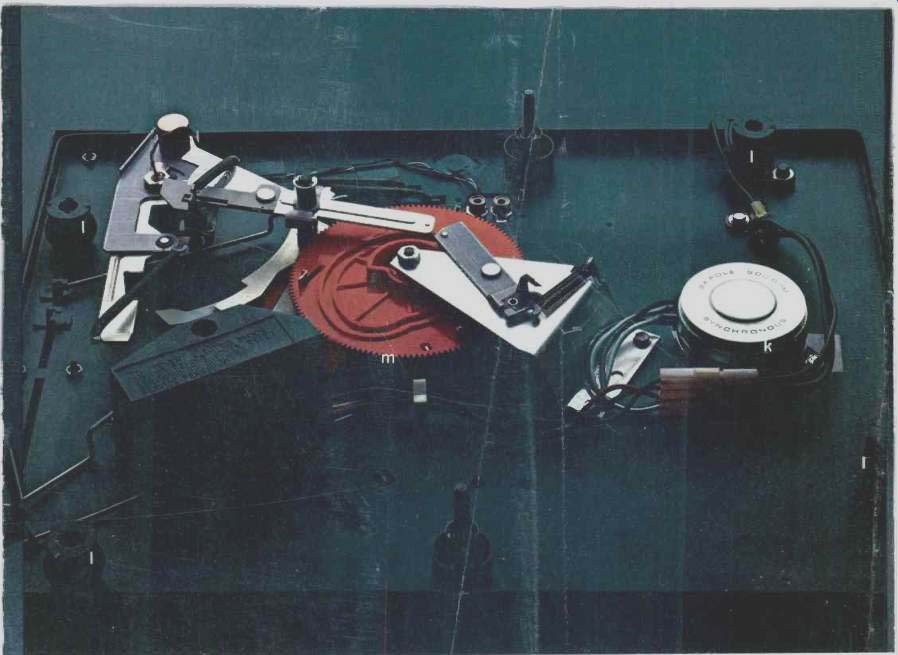
To play one record automatically (which we recommend for the sake of your cartridge and your records) move the program lever to "1", tap the cycle button (j) and the play-shut off cycle proceeds. Perhaps the most unique feature of the program system is that it allows you to preprogram as many as 6 plays of a single record and then shuts the machine off automatically after the program is completed.
The cycle button is worth noting in that it requires only a feather touch (90 grams pressure) and travels only .0625". It controls all functions with so light a touch that it precludes jarring of the unit plate, and accidental damage to records or stylus. Even when the tone arm is tracking, the unit can be put into "reject" smoothly, without jarring the tone arm, as frequently happens in most automatics.
For automatic play you can program 1 to 6 records. For example: to play 6 records in sequence, place them on the spindle and steady them with the clip at the outboard edge of the platter. Slide the program lever to "6", press the cycle button, and go about your business. The 2-point record support has no sensing mechanism in the spindle.
It is thus superior to other 2-point systems and completely does away with the instability and hang-ups typical of umbrella spindles. Even records with worn center holes drop smoothly.
The BIC program system is simple to operate. And it has simplified the turntable's underside to the point that the 980 and 960 are actually less complex than some manuals with automatic features which can play only a single side.
Underneath the turntable: The utter lack of confusion on the underside of the BIC turntables speaks for itself. Look under any changer or automatic turntable and you'll be amazed at the number of visible parts BIC engineering has eliminated.
There are other items under here which deserve your attention.
The motor (k) is a 24-pole synchronous unit which operates at 300 RPM. Its advantage is that at 300 RPM its fundamental vibration frequencies are well below audible levels. The 1800 RPM motors used in other automatics have audible vibration frequencies. A 24-pole motor delivers a smoother flow of power than a 4-pole unit. The superiority of the BIC power unit is one of the reasons that initial lab reports on these turntables look so good.
The unit shown above is the BIC 960. If it were the 980 you would see, in addition, the solid-state circuit board which electronically governs speed and incorporates pitch control. The 980 uses electronic circuitry to lock in speed and vary pitch. It is permanently accurate.
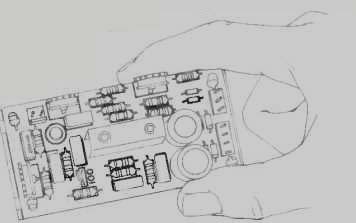
above: The solid-state electronic speed control of the B-I-C 980 allows
pitch variations of-±-3%.
The mechanical "tapered pulley" pitch controls used on other machines, which inevitably go sour with age, have been eliminated.
Notice the four shock mounts (l) which form the interfaces between the unit plate and base...four small rubber Isomer shock mounts, designed specifically for these turntables. They protect the unit from external shock and acoustic feedback. More than that, they are further evidence of the care and attention which has been lavished on every detail in these machines. Compare them with the metal springs used on automatic turntables and you'll quickly see the difference.
The red cam (m) in the middle of things is made of material which is not subject to the wearing effects which metal cams suffer. The material has its own internal permanent lubricity.
The platter (n) shown in the exploded view at right represents another technical advance. Old style heavyweight platters which were used for their flywheel effect are no longer needed because of innovations in electronics and system design. The BIC turntables carry this die-cast non-ferrous, 12" platter, which has been mated by computer analysis to the rest of the drive mechanism.
A few words about our warranty: BIC is the name on our turntables. Your dealer knows the name British Industries Co., very well.
If you have any questions about the special relationship we've had with record playing components for the past 37 years, why not ask him about us. But, reputation or no reputation, you may still ponder the wisdom of jumping into equipment that has not been proved in home trial, no matter how good it looks on paper.
The new BIC Programmed Turntables are engineered to do things no other turntables can do. In the face of more demanding cartridge designs and critical new 4-channel discs, the B I C 980 and 960 appear at just the right moment.
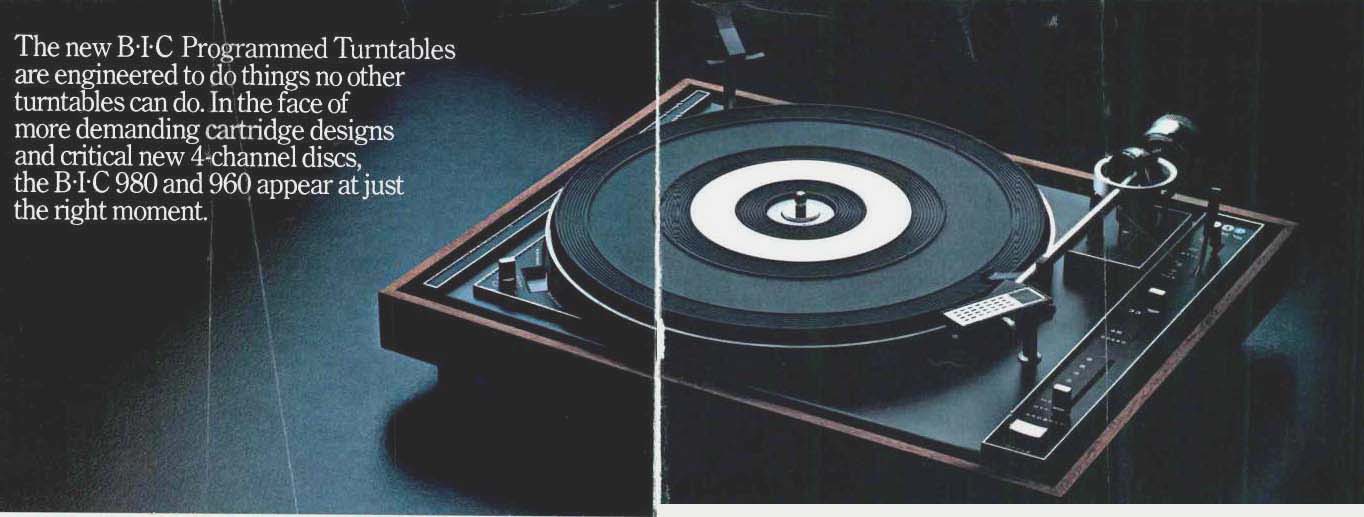
The Status Quo:
The mechanism that turns your records and carries your cartridge has become an increasingly critical part of your audio system.
More than ever before, today's turntable buyer is faced with a classic dilemma.
"Should I buy a single-play manual turntable for its playback superiority?" Or..."should I buy an automatic for its superior record-handling capabilities?" Until now, the dilemma has remained unsolved.
Enter BIC
British Industries Co., creator and builder of the new BIC turntables has been the major innovator in this field since 1936.
No company has better credentials or greater experience with record layback equipment in the components field. The best proof of that is the instruments which BIC now introduces.
The 980 and 960 are unique.
They have been engineered to solve once and for all the "manual vs. automatic" dilemma.
They are belt-drive as opposed to all automatic changers which drive the platter via an intermediate idler wheel.
They are powered by a 24-pole, low speed (300 RPM) motor while most automatics use 4-pole, high RPM motors.
In all three areas of function-platter drive, tone arm system, and multiple play capabilities, the BIC turntables offer refinements and advances which set them apart from everything else in the market.
As a matter of fact, several BIC turntable features are not to be had on any other instrument at any price.
A Brief Introduction
The BIC 980 is shown above. It is identical to its companion, the 960, except for the 980's electronic drive, pitch control, and lighted strobe which are discussed later in this announcement.
You have probably already noticed its low profile. This is not an optical illusion or a styling trick. The 980 and 960 are indeed as low and trim as they appear.
This lack of bulk is your first clue that the BIC turntables are not merely manuals with automatic features added ... that they are in fact "originals", designed from the start to be simple, as only sophisticated engineering can make them.
Moving parts found in conventional automatics have been eliminated right and left. In the process, potential sources of malfunction have disappeared. Potential sources of noise and vibration have also been eliminated.
Operating controls are grouped in a single program panel on the right side of the unit. To say that this panel brings new logic to the turntable and new refinement and simplicity to its operation, barely does it justice.
The tone arm incorporates several dramatic improvements which set it apart from all others.
And of course you have noticed at the bottom of the page a cutaway drawing of the BIC platter which reveals the belt drive mechanism. No other turntable which can play more than a single record offers belt-drive and all its advantages.
The drive system alone sets BIC turntables apart. But there's more.
These turntables are built entirely in the United States of American-made parts.
They are built in BIC's own plant where all aspects of manufacturing are in BIC's hands. They are the first fine turntables of their type built in this country, and they meet and exceed the high standards you have come to expect only from imported equipment. Beyond what that means in technical terms, they do not come to you burdened with import duties or fluctuating exchange rates.
They are rugged. They are built of the best materials that can be had.
The 980 will sell for about $200. The 960 for about $150. While they are not inexpensive, they will stand stringent comparison with machines costing $100 to $200 more. Anything less, they outperform by a wide margin.
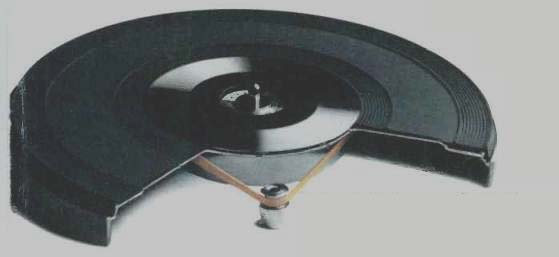
-------- Belt drive eliminates the wow, flutter, and rumble-causing problems
of idler drives used almost universally in automatic turntables and record
changers.
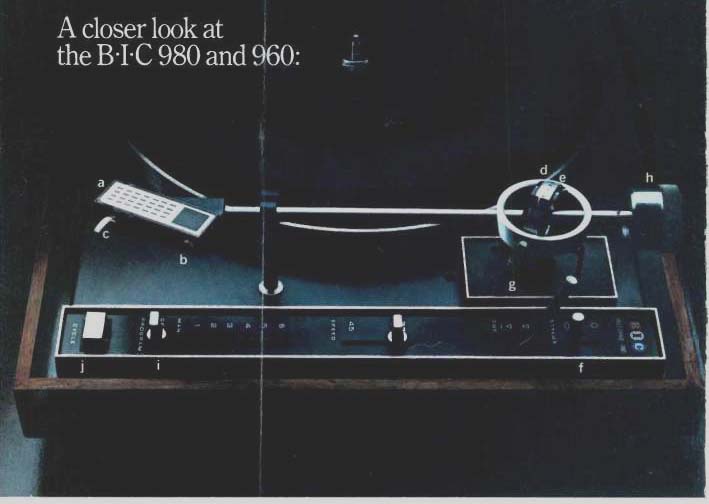
A closer look at the BIC 980 and 960:
The tone arm system: The BIC tone arm incorporates both simple refinements and radical departures from current designs. The result is a system which is, in our view, better than anything else now offered. Let's review its features from left to right as you see them pictured above.
The cartridge shell (a) has two precision adjustments to combat playback distortion. In mounting the cartridge, overhang can be adjusted with the aid of a gauge which is supplied. And, for the first time, stylus angle is also adjustable, using the gauge and set-screw (b) in the side of the shell. Regardless of cartridge depth or other variables, the stylus can be set to track at precisely 15°-the forward vertical angle that generates lowest playback distortion.
The cartridge shell is securely mated to the tone arm by a fail-safe, 4-prong, side-mounted connector, and is locked in place by a threaded knob. This eliminates the potential problem of intermittent signal inherent in slide-in cartridge carriers which are used in automatics.
Even the finger lift (c) is a pleasure to use. It is a wide stainless steel arc like those on studio turntables. It is one more indication that these BIC turntables have been designed for the serious hobbyist.
The geometry of the tone arm brings lateral tracking error down to .3° of arc per inch, which is insignificant in terms of playback distortion. The pivotry of the tone arm produces another important result.
When 6 records are played in series there is virtually no variation in tracking force from first record to last. This variation in tracking force, found in other machines, has been a major criticism of automatics.
The arm is mounted in a minimal friction gimbal and is designed to track flawlessly at forces below the lowest limits of any cartridges now available or conceivable at this time.
Anti-skating and stylus force adjustments (d, e) are mounted in tandem over the gimbal where they flank a single linear scale, calibrated in 0.25 gram increments. Gone are the usual separate scales for conical and elliptical stylii. Selection of stylus mode is made by a separate lever (f) on the program panel at the right of the tone arm.
Cueing is viscous-damped in both directions and, for the first time, its rate can be adjusted. A small knob at the base of the tone arm (g) allows you to vary climb and descent for from 1 to 3 seconds. This adjustment is found only on BIC turntables. It enables the owner to accommodate his personal preference and also provides a means to compensate for variations in cueing time caused by changes in ambient temperature.
The massive counter balance (h) is completely isolated from the arm and incorporates a knurled band which makes balancing the arm fast and accurate. The entire tone arm system is protected by a safety bar which makes it virtually impossible to drop the arm on a record or on the platter.
The program system: The BIC turntables have been designed to play as many as 6 records in series. At the same time, the design eliminates some important criticisms which have been leveled at automatic changers in the past.
Automatic changers use a complex series of gears, cams, and levers to sense the number of records stacked on the spindle, and to activate the machine. The BIC design eliminates this sensing mechanism. Instead, all cycling information is set on the program panel by the operator. Many parts, a good deal of weight, noise, and vibration, are eliminated. Reliability is greatly improved.
To play one side this is all you do.
If you are hooked on manual play, insert the single play spindle which rotates with the platter. Move the program lever (i) to "MAN" and place the arm on the disc. After play the arm will return to rest and the machine will shut off.
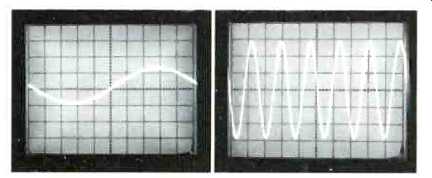
----- B.I.C's 24-pole motor (left) has sub-sonic fundamental rotation
frequency of 5Hz with harmonics all below audible range. 4-pole units (right)
have fundamental frequency of 30 Hz and harmonics all fully audible.
Printed in U.S.A. Copyright 1974 BIC is a trademark of British Industries Co, Westbury, New York 11590. A division of Avnet Inc.
( Audio magazine, Aug. 1974)
Also see:
BIC Turntables (ad, Sept. 1974)
B-I-C cassette decks (Dec. 1978)
= = = =